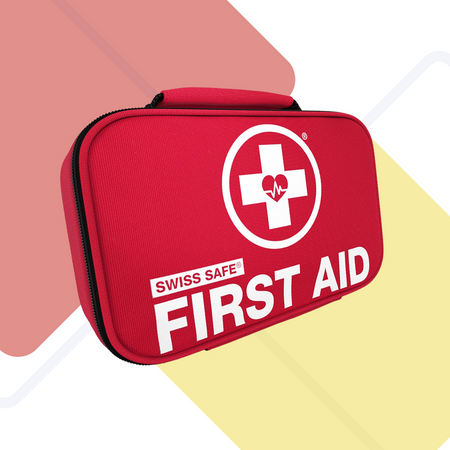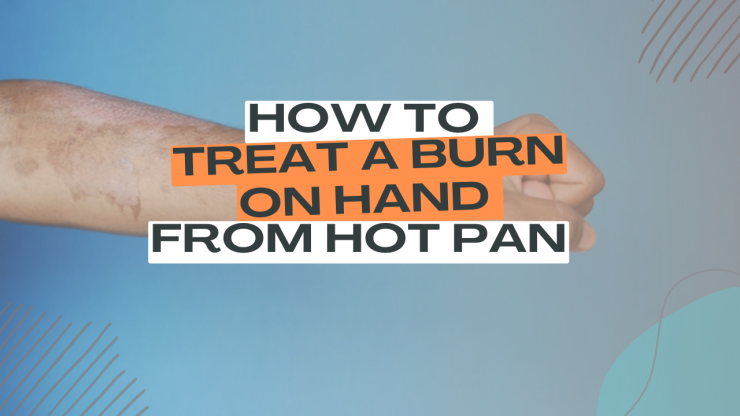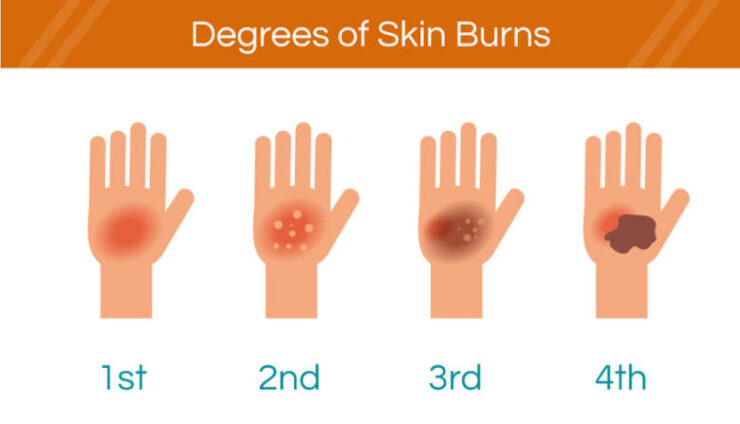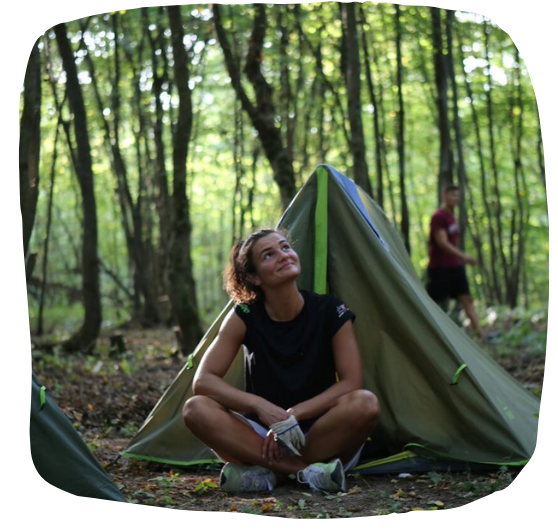A minor burn is the most common household injury as well as during outdoor activities such as camping. Suppose, you are cooking pancakes in the pan; meanwhile you were thinking about having them for breakfast and touching the hot pan. Now, are those pancakes tasty enough to make up for that red spot glowing on your hand? No defiantly not even a minor burn is certainly not pleasant.
Afterward, you might ask yourself a question about how to treat a burn on your hand from a hot pan? But not to worry, in this article, we are going to explain treatments for different grade burns. Moreover, this article will cover when to use home remedies, assistance from the first aid kit, or seek proper medical care.
The severity of the burn determines what kind of treatment you need. Burns are categorized by severity of the burn and fall into four categories:
Contents
First Degree burn:
The least severe burn only affects the upper layer of skin, the epidermis.
Symptoms of this category of burn include:
- Slight redness
- Minor swelling
- No sign of blisters
Observing these signs consider this a First-degree burn, which we can treat at home. Now, I will explain below how to treat a burn from a hot pan which is a First-degree burn.
Second-degree burn:
Affect the second layer of skin known as the dermis. Relatively severe, then the First-degree burn.
Symptoms may include:
- Extreme redness
- Very painful
- Blisters
- The affected area would be less than 3 inches
Usually, a second-degree burn can be treated at home using a proper first aid kit. However, if the blisters are large and very painful, it may require medical attention.
Third-degree burn:
A third-degree burn is considered severe because of its effect on both layers of skin, the epidermis as well as the dermis.
Considered a third-degree burn when:
- The burn area is more than 3 inches
- The burn appeared white, brown, or black
- Feel severe pain
- Numbness due to damaged nerves.
A third-degree burn involves more risk so it should be treated at a hospital, and you should seek immediate medical help.
Fourth-degree burn:
Most severe of all, damage most layers and goes deeper into the body. Affect muscles, tendons, and joints.
Third and fourth-degree burns are considered life-threatening, and must be treated in the hospital as soon as possible without trying any home remedies.
Signs and symptoms of different degrees of burn
How to Treat a Burn on Hand From a Hot Pan Using Household Things (Home Remedies)
You can judge your burn, whether it’s a first grade or any other grade burn following the above symptoms that I explained. Then you can treat your burn accordingly. If it’s a first-grade or even second-grade burn, it will be considered as a minor burn. You can treat those burns by yourself at home, using the following home remedies and first aid kit.
How to treat a burn on hand from a hot pan or how to treat a burn from a hot pan and what to put on a burn to stop pain would need the following household things which are very usual possession of anyone:
Some home remedies for burns on the hands are explained below if you are wondering what to put on a burn at home it’s the best place to learn:-
1: Cool water (Not cold)
The first thing for First grade or second-grade burn is to run cool water over the burn for 15 minutes; This will cool down the skin and absorb heat which would penetrate further deep into the skin and damage lower layers of skin. Moreover, this will help to relieve pain and swelling.
2: Cool compression
If running water is not available, e.g., you are camping. Use a clean wet towel or can use a damp gauze pad over the burn, do this for 15 to 20 minutes, this will help from worsening the swelling.
3: Clean the burn
After running the water or cool compression, it’s time to clean it thoroughly. Use mild antibacterial soap with water. If blisters are excessive, avoid scrubbing as a broken blister can lead to infection.
4: Aloe Vera
Aloe Vera is one of the common ingredients in cosmetics. Aloe Vera has anti-bacterial properties, which prevent bacterial growth. It’s a typical remedy to treat burns and promote healing. For a minor burn, it’s handy to apply a layer of aloe Vera and which doesn’t even need dressing the wound. This is one of the best remedies for treating a burn from a hot pan. A systematic study on the efficiency of aloe Vera to treat burn shows its effectiveness.
5: Honey
Honey is not just sweet; it’ll get even sweeter if you know it has natural anti-fungal and anti-bacterial properties. Apply honey with a bandage on the burnt area; this will ease pain and also soothe burned skin.
These are the best home remedies and the best answers to questions, about how to treat a burn on the hand from a hot pan, which is a minor burn.
How to Treat a Burn on Hand From a Hot Pan, Having a First Aid Kit
These were the home remedies that can be useful if you don’t own a first aid box with you with proper bandages and ointments. The above remedies also answer the question” what to put on a burn to stop the pain ”.
All these remedies are beneficial to relieve some of the pain due to burning., mostly for First-grade burn. However, it is convenient to treat a second-grade burn with a first aid kit for better results.
Second-grade burn requires relatively more care than first-grade burn. So it’s practically better to treat a second-grade burn with adequate antibiotic cream and dressing over it. For this purpose, you need to own a first aid kit with several things required for treatment.
Following thing should be in the first aid kit to treat a burn from a hot pan:

- Surgical scissors (For cutting gauze or adhesive tape)
- Antiseptic pads/ antibiotic ointment/Cream
- Latex gloves/ disposable gloves
- Safety pin (To fix bandage)
- Sterile gauze dressing/pad
- Gauze bandage
- Gauze pad
- Pain killer (Ibuprofen)
Having these things with you need to follow the steps mentioned below:
- Run cool water over the burn for 15 minutes.
- Wash your hands thoroughly or use latex gloves to prevent infection.
- Clean the burn using a wet gauze pad to avoid scraping, as the blister will break and the risk of infection is involved.
- Gently, dab antibiotic cream over the burned area.
- Now, Place a gauze pad over the burned area, then wraps this with a gauze bandage. Proper dressing of wounds will avoid any infection to grow.
- Avoid using adhesive bandages as this will cause pain while removing.
- Change your bandage daily and check on the progress of the wound. If it’s not getting better, consult with a doctor.
- As burns are excruciating. You may need painkillers to get over excessive pain. You can try (Ibuprofen, Acetaminophen, Naproxen sodium). If you are on other medication, consult with the doctor first before using painkillers.
Caution: First try not to break the blister if the blister does break accidentally, carefully clean it with water and mild soap. Apply ointment and cover it with a bandage or surge gauze.
Tip: Swelling may occur so better to remove tight items such as rings or clothes from the affected area.
NOTE: Ensure that you had a shot of tetanus in recent years if haven’t, please consult with your health provider because you can get tetanus through open skin.
The above discussion was related to how to treat a burn from a hot pan, which is not a third or fourth-grade burn. If it seems your burn is extremely severe and falls into the third-grade or fourth-grade burn, rush to the nearest hospital or call emergency for help immediately, do not use any home remedies.
However, you can do these things while waiting for medical help:
- Apply the clean wet cloth to the burnt area
- Raise the burnt area above heart level if possible
- Keep body warm
- Don’t treat with cold water or ice as it will lead to shock and risk of frostbit involved.
Watch the following video for tips on how to treat a contact burn:
Things to Avoid When Treating a Burn From a Hot Pan
Aside from knowing what steps to take when treating a burn from a hot pan, it is also essential to know what to avoid. There are countless myths and misconceptions related to this topic, and it includes some products that are said to be beneficial but actually are not recommended. Here are several examples of such products.
1: Ice
Although it is true that a cool compress can reduce the pain, something so cold as ice will not give you desired results. If you decide to put ice on a burn, you might irritate it and later on regret this decision. Just a bit of cool water should be enough to do the trick.
2: Toothpaste
One of the most popular myths when it comes to burns is that you should apply some toothpaste to your burn. Needless to say that this is not backed by research or studies, and you should not do this.
In fact, this method may put you in even more danger and put you at risk of infection. Use burn ointments, lotions, honey, or aloe vera, which are well-known for their healing properties.
3: Butter
Another misconception about burns is that butter can alleviate the pain. Moreover, it is likely that you will have some of it around in the kitchen. However, you should not apply it to your burn as it can actually make the condition even worse.
This is due to the fact that butter has good heat retention, which is why it serves as an alternative to oil in cooking. Applying butter on a burn may even feel like it starts getting hotter and can put you at risk of bacterial infection.
4: Oil
It is wise to avoid applying oil to your burn for the same reason that butter is a bad idea – it retains heat efficiently. The same goes for different types of oil like coconut oil, olive oil, and traditional cooking oil. It will keep your burn warm and give you the exact opposite effect of what you want to achieve.
Additional Tips for Faster Recovery From Burns
When you accidentally get burned on a hot pan, it is essential to apply the right treatment, but also to avoid any hazards that might slow down the whole recovery process. Here are some additional tips to improve the healing process.
1. Avoid Exposing Your Burn to Direct Sunlight
You should avoid exposing your burn to direct sunlight as much as you can. It is a very sensitive area, and it is vulnerable to the heat which the sun emits.
2. Do Not Touch or Burst Your Blisters
Blisters are parts of the skin filled with fluid that will likely develop when you experience burn. It may be very tempting to pop them, but you should avoid doing so, as it may put you at risk of infection.
3. Take Some Medication if You Cannot Endure the Pain
If the burn you have experienced keeps stinging and you cannot endure any more pain, do not torture yourself and take some over-the-counter pain relieving medicine. These meds will help you soothe the pain for a while.
4. If You Feel That the Burn Is More Than Minor, Visit Your Doctor ASAP
If your burn looks alarmingly bad and the pain keeps persisting even after you apply the ointments we have mentioned today, you should immediately go to your doctor.
This is very important because if the burn cannot be treated in the household, there can be risks of developing an infection. Anything higher than second-degree burns requires special and professional medical care, so do not attempt to treat it on your own.
Final Words
Knowing the process of treating burns is very important, especially if you are a professional chef or someone who spends a lot of time in the kitchen. One of the most important things to memorize is what different burn degrees look like.
For first and second-degree burns, you can manage the treatment in your household. However, anything higher than that requires professional care.
References:
- https://www.mayoclinichealthsystem.org/hometown-health/speaking-of-health/ouch-ive-burned-my-hand
- https://www.everydayhealth.com/columns/white-seeber-grogan-the-remedy-chicks/ouch-youve-burned-your-hand-on-a-pan-of-brownies-now-what/
- https://www.healthline.com/health/home-remedies-for-burns
I love camping! There’s nothing like being in nature, getting away from the hustle and bustle of everyday life.





